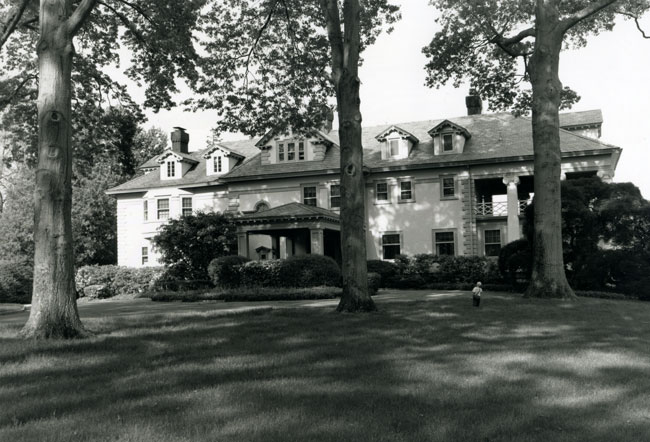
A famed allee of Pin Oak trees leads from Field Point Circle to Easterly, a home in the Beaux Arts style directly fronting the waters of Long Island Sound. Built in 1902 for George Francis and Emma Dominick, the house was one of the first to be completed in the residential park, while fulfilling the land association requirements that it be finished within one year, be worth a minimum of $15,000 and be set back from the road by at least 130 feet.
A classic Greenwich shorefront estate in the Neoclassic style, it has survived almost virtually intact.
Originally, four acres, the house now crowns just over two acres of lawns rolling past a swimming pool and down to a seawall and deep-water dock crafted of fieldstone. Overlooking the route of the Island Beach ferry, it is set almost 60 feet above sea level and is a monument to its lavish era.
The house has a wooden frame swathed in stucco, and wooden quoins punctuate every corner. The hipped roof, shingled in slate, runs along the 106-foot length and 30-foot depth of the home.
A circular motor court leads to a porte-cochere with paneled piers, and to one side is a large open-sided porch detailed with massive columns in the Ionic style. Above on the third level are five pedimented dormers.
A long, wide porch runs along the rear façade of the house with nine Tuscan columns giving support. A cross gable has a centrally-placed, five-sided bay that rises two stories and has an enclosed balcony. Four corbeled chimneys soar above the roofline.
The formal entry with fanlight opens to a wide reception hall with beamed ceiling, running from the front to the back of the house. The airy main rooms are large with high ceilings and carved classical moldings. There are nine fireplaces within, some surrounded with columns and hand-painted tiles. The library has a concealed wet bar, and the dining room has a cove ceiling, a water view bay window and elaborate corner cabinets.
The master suite has two baths, a library and a closet-lined dressing room, featuring décor in the form of rosettes, wreaths and swags. The third floor, tucked under eaves and dormered windows, offers a guest room, two offices, a wardrobe room and a staff suite of four bedrooms and bath.
George Dominick grew up in Greenwich and was a member of the tea merchants, Dominick, Hoag & Co. at 95 Wall Street in Manhattan and of Dominick & Dominick, a banking firm founded in 1870, one of the original sources of closed-end funds, a company that continues its work today 142 years later. A former director of commodities at the firm is another Greenwich resident, Ray Dalio, founder of Bridgewater Associates, the largest hedge fund in the world.
Two years after the Dominicks moved in, son, Lamont, an 1893 graduate of Yale, performed a daring sea rescue of three of the family’s workmen. Tossed from a capsizing rowboat and unable to swim, the men were saved by Lamont who dove after them, dragged the men ashore and rolled the men on barrels enabling them to disgorge the L.I. Sound waters they had swallowed.
Philanthropic, Dominick served as chairman of the building committee of Christ Church and donated the original parish house.
The architect of the house was the well-known Charles Alonzo Rich of Lamb & Rich in New York. Rich, who designed everything from a cigarette factory to town houses and an armory in New York, was active in the Greenwich community. Among others, he designed a house for Nathaniel Witherill in Belle Haven¸ one for Elizabeth Milbank, another for George Lowther in Riverside and the original Greenwich Library on Greenwich Avenue.Also an institutional architect, he designed buildings for Dartmouth, Smith, Barnard, Colgate, Amherst and Williams Colleges.
The articles were featured in the greenwich.patch.com throughout 2012.

